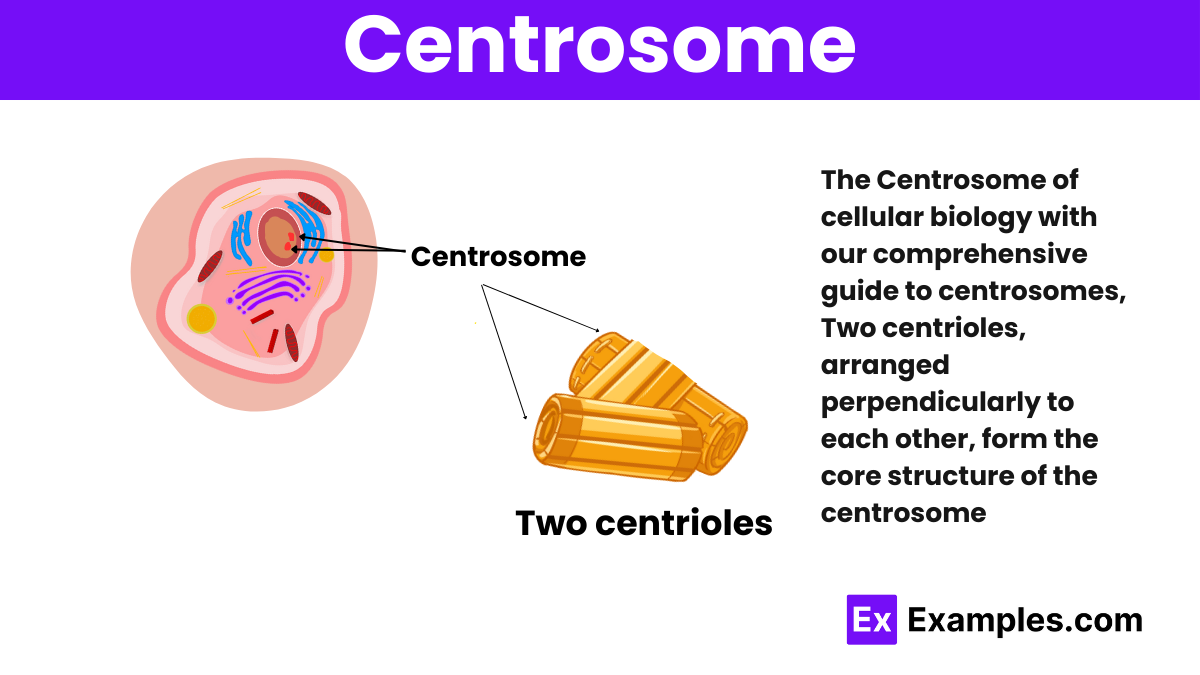What is the primary function of the centrosome?
DNA replication
Protein synthesis
Organization of microtubules
Energy production


The Centrosome of cellular biology with our comprehensive guide to centrosomes, Two centrioles, arranged perpendicularly to each other, form the core structure of the centrosome in animal cells. This detailed exploration offers insights into the structure, function, and crucial role of centrosomes in ensuring accurate chromosome segregation and maintaining cellular integrity. Through vivid examples, learn how centrosomes influence cell cycle progression, mitosis, and overall cellular health. Enhanced with cutting-edge research and easy-to-understand explanations, this guide is your gateway to understanding one of the cell’s most fundamental components.
The centrosome is a crucial cellular structure that plays a key role in the organization of microtubules in animal cells. Positioned near the nucleus, the centrosome acts as the main microtubule organizing center (MTOC) of the cell, facilitating the assembly of the microtubule network that spans the entire cell. This network is essential for various cellular processes, including cell division, intracellular transport, and maintaining the cell’s shape and structure. A typical centrosome comprises two orthogonally arranged centrioles surrounded by a complex and amorphous matrix known as the pericentriolar material (PCM). The centrioles are cylindrical structures, each made up of nine triplets of microtubules, and they play a pivotal role during cell division.
The centrosome is a key cellular structure, pivotal in the organization of microtubules and in facilitating the process of cell division. At its core, the centrosome comprises two orthogonally arranged cylindrical structures known as centrioles, surrounded by a complex and dynamic matrix of proteins called the pericentriolar material (PCM). Each centriole measures approximately 500 nanometers in length and is composed of nine triplets of microtubules arranged in a circular pattern.
The centrosome plays several vital roles in cellular processes, notably in:
Plant cells typically do not have centrosomes as found in animal cells. Instead, they possess structures called microtubule-organizing centers (MTOCs) that perform a similar role in organizing the cell’s microtubules. These structures are crucial during cell division, especially in the formation of the spindle apparatus, but they do not contain the centriole pair commonly found in animal cell centrosomes. Plant cells rely on other mechanisms and structures to organize their microtubules and ensure proper cell division and growth.
In animal cells, the centrosome plays a pivotal role in organizing microtubules, which are essential for cell shape, organization, and division. Each centrosome contains a pair of centrioles surrounded by protein-rich material known as pericentriolar material (PCM) which aids in microtubule nucleation and anchoring. The centrosome duplicates before cell division, with each pair organizing the spindle fibers required for chromosome segregation. This ensures that each daughter cell receives the correct number of chromosomes, maintaining genetic stability.
The main function of a centrosome is to organize microtubules and regulate the cell cycle, especially during cell division.
Centrosome amplification refers to the presence of more than two centrosomes in a cell, often linked to cancer progression.
Without a centrosome, a cell might face difficulties in organizing its microtubules, leading to errors in cell division and structure.
The centrosome, as the cell’s microtubule organizing center, is fundamental to cellular integrity and functionality. It orchestrates the layout of the cellular skeleton, ensuring accurate cell division and proper cellular organization. The study of centrosomes not only deepens our understanding of cell biology but also unveils potential targets for therapeutic interventions in centrosome-related diseases. Its pivotal role in cellular processes highlights the importance of meticulous regulation for maintaining cellular and organismal health.
Text prompt
Add Tone
10 Examples of Public speaking
20 Examples of Gas lighting
What is the primary function of the centrosome?
DNA replication
Protein synthesis
Organization of microtubules
Energy production
Centrosomes are most commonly found in which type of cell?
Bacterial cells
Plant cells
Animal cells
Fungal cells
The centrosome is composed of two structures called:
Nucleoli
Ribosomes
Centrioles
Lysosomes
During which phase of the cell cycle does the centrosome duplicate?
G1 phase
S phase
G2 phase
M phase
What role does the centrosome play during mitosis?
It dissolves the nuclear membrane.
It forms the spindle apparatus.
It replicates DNA.
It synthesizes proteins.
Centrosomes are absent in which of the following organisms?
Fish
Insects
Mammals
Higher plants
Which protein is primarily associated with the function of centrosomes?
Actin
Tubulin
Myosin
Keratin
In which cellular structure are centrosomes located?
Nucleus
Cytoplasm
Cell membrane
Mitochondria
The pericentriolar material (PCM) surrounding the centrioles is important for:
Energy production
DNA transcription
Microtubule nucleation
Cell signaling
Which structure attaches to the centrosomes during mitosis to help pull chromosomes apart?
Kinetochores
Spindle fibers
Ribosomes
Vesicles
Before you leave, take our quick quiz to enhance your learning!

